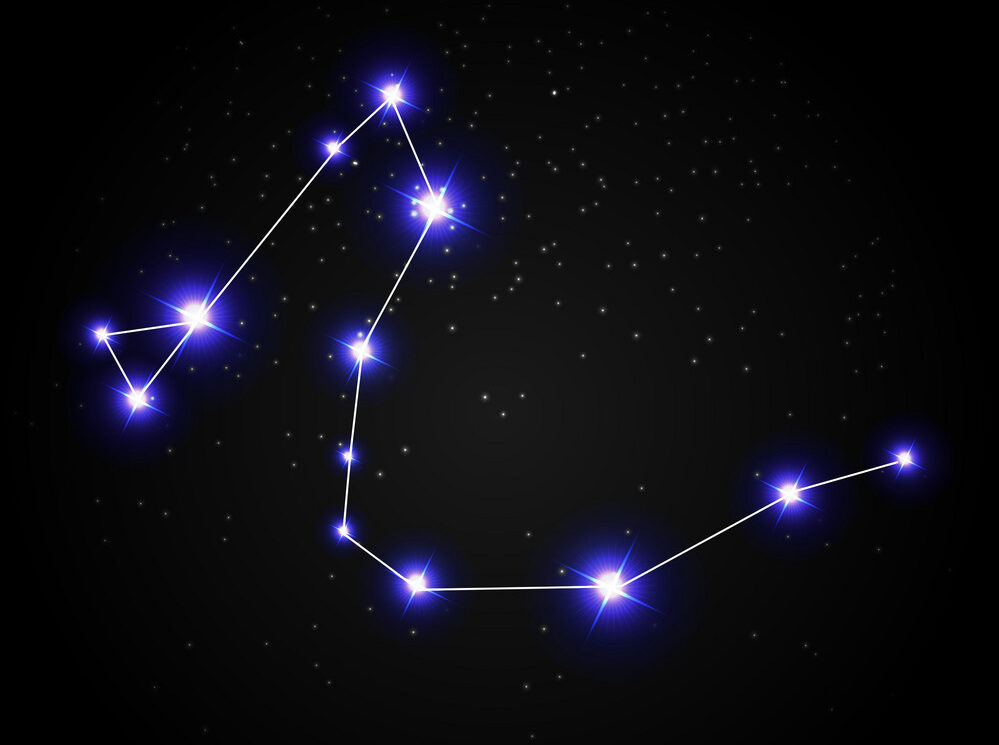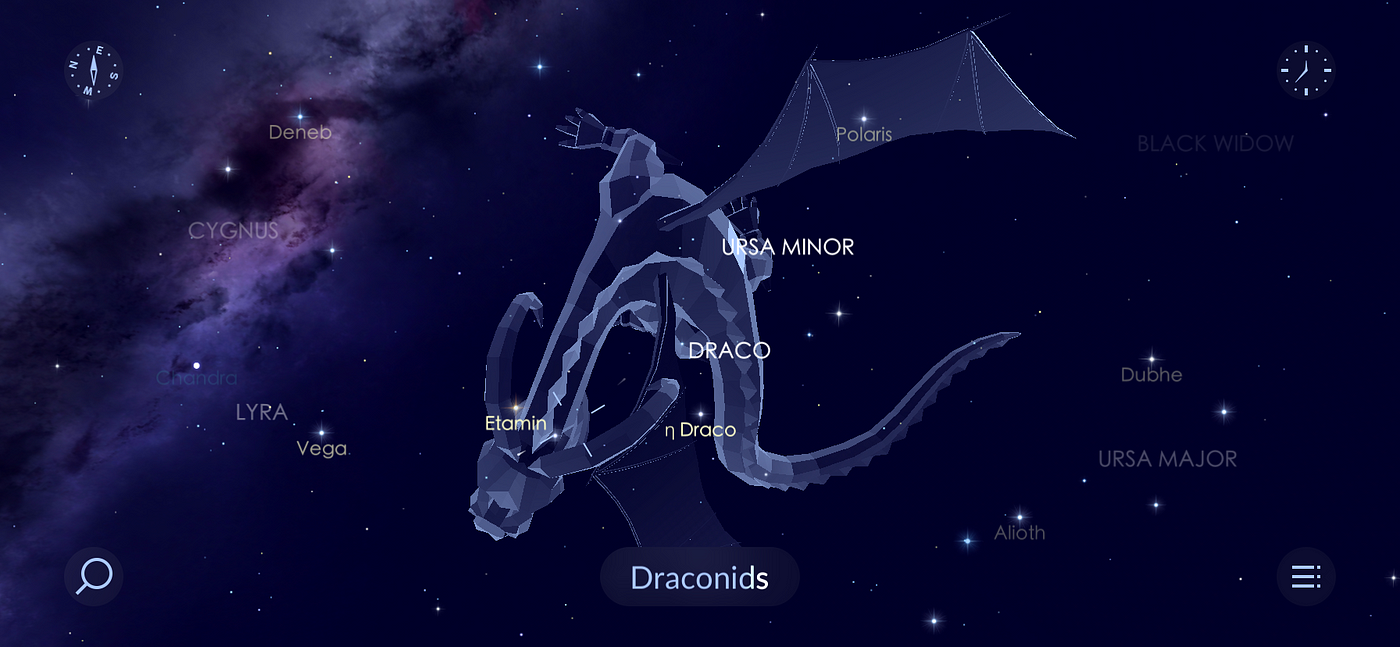Draco Constellation; Facts, Myth, Location, Stars
- Home
- chevron_right
- Constellation
- chevron_right
- Draco Constellation; Facts, Myth, Location, Stars
The night sky has always been a source of human wonder and fascination. The Draco constellation holds a special place in mythology and astronomy among the many constellations that adorn the celestial canvas. If you want to know more about this fascinating constellation, you can walk through it in this article to figure out the Draco constellation’s facts, myths, locations, and stars.
Facts of Draco Constellation; A Celestial Serpent with a Long History
The name of Draco is pronounced /ˈdreɪkoʊ/. The Dragon constellation is its English name. When referring to star names, Draco’s genitive form is Draconis (pronounced as /drəˈkoʊnɪs/). The International Astronomical Union (IAU) adopted the three-letter abbreviation Dra in 1922.
Draco is one of the 88 modern constellations and is the eighth largest in terms of area. It was first cataloged by the Greek astronomer Ptolemy in the 2nd century, making it one of the 48 constellations listed in his Almagest. The constellation is visible throughout the year in the Northern Hemisphere, making it a circumpolar constellation. This means it never sets below the horizon, allowing stargazers to enjoy its beauty all year round. Among its famous deep sky objects are the Cat’s Eye Nebula, the Spindle Galaxy, the Tadpole Galaxy, and nine stars with known planets. Draconids is the only meteor shower f this constellation.
Seventeen stars make up the Draco Constellation. The name of stars, according to the International Astronomical Union (IAU), are Aldhibah, Alrakis, Alruba, Alsafi, Altais, Athebyne, Dziban, Edasich, Eltanin, Fafnir, Funi, Giausar, Grumium, Rastaban, Taiyi, Thuban and Tianyi. The brightest star in the constellation is Eltanin.
Location of Draco Constellation; Navigating the Night Sky
One must first find the North Star, Polaris, part of the Ursa Minor constellation, to locate the Draco constellation.
Draco winds its way around Ursa Minor, with its head between the constellations Hercules and Ursa Major. The best time to view Draco is in July at 9 pm when it reaches its highest point in the sky.
Draco constellation covers 1083 square degrees and lies in the third quadrant of the northern hemisphere, visible between +90° and -15° latitude.
Stars of Draco constellation; The Luminous Scales of the Dragon
The Draco constellation is home to several notable stars, each with its unique characteristics:
-
Thuban (Alpha Draconis)
Once the North Star around 2700 BCE, Thuban is a giant white star located approximately 303 lightyears from Earth with an apparent magnitude of 3.645. Thuban is 250 times brighter than the Sun. Although Polaris has replaced it with the North Star, Thuban still holds historical significance. Because of precession, zodiac signs move one degree every 70 years. It is a binary star with a companion star around the major star, either a red dwarf or a white dwarf.
-
Eltanin (Gamma Draconis)
The brightest star in Draco, Eltanin, is an orange giant star situated about 69 lightyears away from the Sun with an apparent magnitude of 2.24. Its name is derived from the Arabic word At-Tinnin, meaning “the serpent” or “the dragon.”
Gamma Draconis is a giant star belonging to the spectral class K5 III. It is 471 times brighter than the Sun and has 72 percent more mass. It has a companion with an apparent magnitude of 13.4, likely a red dwarf. This companion may be a physical companion, not just an optical one. It is easy to find Eltanin in the sky, located northwest of Vega, and one of the brightest stars in the Lyra constellation.
-
Rastaban (Beta Draconis)
A yellow giant star, Rastaban, is located around 380 lightyears from Earth with a visual magnitude of 2.79. it is 950 times brighter than the Sun and has 40 times the radius of the Sun. Its name also has Arabic origins derived from Ra’s ath-thu’ban word, meaning “the serpent’s head.”
-
Aldhibah (Zeta Draconis)
A blue-white star, Aldhibah, is approximately 330 lightyears away with a visual magnitude of 3.17. Aldhibah’s name is derived from an Arabic word that means “the hyenas”. This star is called Nodus III, or Third Knot mentioning the dragon tail. Zeta Draconis is 148 times brighter than the Sun, and its radius is 2.5 times larger.
-
Iota Draconis (Edasich)
Iota Draconis, also known as Edasich, is a giant star of the K2 III spectral type. It is located 101.2 light years away from Earth and has a visual magnitude of 3.
In 2002, a planet was discovered orbiting Iota Draconis, which was the first planet found to orbit a giant star. The star is slightly more massive than the Sun, has almost 12 times the solar radius, and is 55 times more luminous. Additionally, it is thought to have a debris disk.
-
Chi Draconis (Batentaban Borealis)
Chi Draconis is a star system consisting of a yellow-white F7V star with a visual magnitude of 3.68, almost twice as the Sun, and an orange K0V star with a magnitude of 5.67. The system’s combined magnitude is 3.570, which is 26.3 lightyears away.
The stars form a spectroscopic binary and orbit each other with an average separation of just under an astronomical unit, completing one orbit every 280.55 days.
-
Phi Draconis (Batentaban Australis)
Phi Draconis is a multiple-star system located about 300 light years away. It has an apparent magnitude of 4.2004 and cannot be seen in latitudes south of the Tropic of Capricorn. The system comprises hydrogen-fusing dwarfs, with the two brighter components orbiting each other for 307.8 years. The primary component, Phi Draconis A, is an unresolvable binary star and has a stellar classification of A0sp.
-
Epsilon Draconis (Tyl)
Epsilon Draconis is a yellow giant star of the G8III spectral type, located approximately 148 light years away, with a visual magnitude of 3.9974. It is relatively young for a G-class star, estimated to be around 500 million years old.
The star is 60 times more luminous than the Sun and takes about 420 days to complete one revolution. It has a rotational velocity of 1.2 km/s and a companion, an orange K5 dwarf star with a visual magnitude of 7.3, located 3.2 arc seconds away.
-
Kappa Draconis (Shǎowèi)
Kappa is a blue giant star of the B6 IIIe spectral class, located approximately 490 light years away with a visual magnitude of 3.82. It is about five times more massive than the Sun and 1400 times brighter. Although it was the closest visible star to the North Pole from 1793 to 1000 BC, it was not considered the pole star because Beta Ursae Minoris (Kochab) was significantly brighter.
The Mythology of Draco Constellation; The Dragon in the Sky
The Draco constellation has a rich mythological background that spans various cultures. In Greek mythology, Draco is often associated with the dragon Ladon, who guarded the golden apples in the Garden of the Hesperides.
This fearsome creature was eventually slain by the hero Heracles as part of his Twelve Labors. In other legends, Draco is linked to the dragon that battled the goddess Athena during the Gigantomachy, a war between the gods and giants. After defeating the dragon, Athena placed its body in the sky as a constellation.
The bottom line
The Draco constellation is the largest in the sky in the northern hemisphere. Its rich history, intriguing mythology, and prominent stars make it a fascinating subject for amateur and professional astronomers. The Greek astronomer Ptolemy first recorded the constellation in the 2nd century. It symbolizes Ladon, the dragon that protected the gardens of the Hesperides in Greek mythology. We hope you find this article useful in covering all the facts, locations, stars, and myths about the Draco constellation. What fascinates you more about the Draco constellation?
We would love to hear from you in the comment section.
References:
https://www.constellation-guide.com/constellation-list/draco-constellation/
Table of Contents
Recent Posts
- What is Gravity?
- whirlpool galaxy (Messier 51); Facts, Location, Type
- Astronomy; Definition, Types, History and Facts
- Draco Constellation; Facts, Myth, Location, Stars
- Cassiopeia Constellation: Facts, Myth, Location, Stars
- Zodiac Constellations; Facts, Stars, Symbols, Dates, Signs
- Atik Star Omicron Persei; +10 Facts, Myth, Features
- Algol Star β Persei; +10 Facts, Myth, Features
Suggest Posts
- What is Gravity?
- whirlpool galaxy (Messier 51); Facts, Location, Type
- Astronomy; Definition, Types, History and Facts
- Draco Constellation; Facts, Myth, Location, Stars
- Cassiopeia Constellation: Facts, Myth, Location, Stars
- Zodiac Constellations; Facts, Stars, Symbols, Dates, Signs
- Atik Star Omicron Persei; +10 Facts, Myth, Features
- Algol Star β Persei; +10 Facts, Myth, Features
Categories

Nazanin Teymoori
Hi there, I am Nazanin, a member of the Aquilae Constellation team. And also the author of all the texts of this blog.
I am delighted that after many years of great interest in astronomy, I launched this website with the help of our professional team. We have many challenges ahead of us, but we promise ourselves that we will overcome everything.
I love astronomy So Let's go






